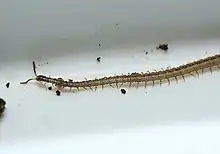Schendylidae
Schendylidae is a family of centipedes in the order Geophilomorpha.
| Schendylidae | |
|---|---|
 | |
| Ballophilus sp. | |
| Scientific classification | |
| Domain: | Eukaryota |
| Kingdom: | Animalia |
| Phylum: | Arthropoda |
| Subphylum: | Myriapoda |
| Class: | Chilopoda |
| Order: | Geophilomorpha |
| Family: | Schendylidae Cook, 1896 |
Taxonomy
The family is paraphyletic (with respect to Ballophilidae) family of soil centipedes in the order Geophilomorpha and superfamily Himantarioidea.[1] There are at least 47 genera and 310 described species in Schendylidae.[2][3][4]
Description
Compared to most other families in the suborder Adesmata, this family features a modest number of leg-bearing segments (no more than 87[5]) and limited variation in this number within each species (usually no more than three or four contiguous odd numbers).[6]
This family includes the two species with the fewest legs (27 pairs) in the order Geophilomorpha: males in the species Schendylops ramirezi have only 27 pairs of legs, while females have 29, and males in the species S. oligopus have 27 or 29 (usually 29), while females have 31.[7] Furthermore, S. ramirezi is one of only two species in this order in which females have only 29 leg pairs (the other species, Dinogeophilus oligopodus, has 29 pairs in each sex).[7]
The genus Schendylops spans an exceptionally broad range, including other species with notably few legs (e.g., S. perditus, with 35 pairs in males and 37 in females)[7][8] and others with more (e.g., S. inquilinus, with 51 or 53 pairs in males and 53 or 55 in females),[9] all the way up to 87 pairs (in S. caledonica, with 83 pairs in males and 83 to 87 in females),[10] the maximum number in this family.[5]
Genera
- Algunguis
- Apunguis
- Australoschendyla R.E.Jones, 1896
- Bimindyla
- Ctenophilus
- Cymochilus
- Escaryus Cook & Collins, 1891
- Espagnella
- Falcaryus
- Gosendyla
- Haploschendyla
- Holitys
- Hydroschendyla
- Leptoschendyla
- Marsikomerus Attems, 1938
- Mesoschendyla
- Mexiconyx
- Momophilus
- Morunguis
- Nannophilus
- Nannopodellus
- Nesonyx
- Nyctunguis Chamberlin, 1914
- Orygmadyla
- Parunguis
- Pectiniunguis Bollman, 1889
- Plesioschendyla Ribaut, 1923
- Schendyla Bergsøe & Meinert, 1866
- Schendylellus
- Schendylops
- Serrunguis
- Sogodes
- Sogolabis
- Thindyla
References
- Bonato, Lucio (2014). "Phylogeny of Geophilomorpha (Chilopoda) inferred from new morphological and molecular evidence". Cladistics. The International Journal of the Willi Hennig Society. 30 (5): 485–507. doi:10.1111/cla.12060. PMID 34794246. S2CID 86204188. Retrieved 27 October 2021.
- "Schendylidae Family Information". BugGuide.net. Retrieved 2018-02-23.
- "Schendylidae Report". Integrated Taxonomic Information System. Retrieved 2018-02-23.
- "Schendylidae Overview". Encyclopedia of Life. Retrieved 2018-02-23.
- Bonato, Lucio; Edgecombe, Gregory D.; Zapparoli, Marzio (2011). "Chilopoda – Taxonomic overview". In Minelli, Alessandro (ed.). The Myriapoda. Volume 1. Leiden: Brill. pp. 363–443. ISBN 978-90-04-18826-6. OCLC 812207443.
- Minelli, Alessandro; Bortoletto, Stefano (1988-04-01). "Myriapod metamerism and arthropod segmentation". Biological Journal of the Linnean Society. 33 (4): 323–343. doi:10.1111/j.1095-8312.1988.tb00448.x. ISSN 0024-4066.
- Pereira, Luis Alberto (2013-01-01). "Discovery of a second geophilomorph species (Myriapoda: Chilopoda) having twenty-seven leg-bearing segments, the lowest number recorded up to the present in the centipede order Geophilomorpha". Papéis Avulsos de Zoologia. 53 (13): 163–185. doi:10.1590/S0031-10492013001300001. ISSN 1807-0205.
- Pereira, Luis (2009-01-01). "Description of Schendylops jeekeli sp. n., a new geophilomorph centipede (Myriapoda: Chilopoda) from the Paranapiacaba fragment of the Atlantic Forest in Southeastern Brazil, with complementary notes on similar Neotropical species". International Journal of Myriapodology. 2 (2): 167–214. doi:10.1163/187525409X12577705044665. ISSN 1875-2535.
- Pereira, Luis A.; Uliana, Marco; Minelli, Alessandro (2007). "Geophilomorph centipedes (Chilopoda) from termite mounds in the northern Pantanal wetland of Mato Grosso, Brazil". Studies on Neotropical Fauna and Environment. 42 (1): 33–48. doi:10.1080/01650520600915613. ISSN 0165-0521. S2CID 85861076 – via ResearchGate.
- Hoffman, Richard L.; Pereira, Luis A. (1997). "The identity and taxonomic status of the generic names Schendylops Cook, 1899, and Schendylurus Silvestri, 1907, and the proposal of Orygmadyla, a new related genus from Peru (Chilopoda: Geophilomorpha: Schendylidae)" (PDF). Myriapodologica. 5 (2): 16. ISSN 0163-5395.
Further reading
- Foddai, Donatella; Dallai, Romano (1995). Chilopoda, Diplopoda, Pauropoda, Symphyla. Calderini.
- Capinera, John L., ed. (2008). Encyclopedia of Entomology. Springer. ISBN 978-1402062421.